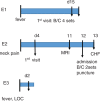Failure of early diagnosis of infective endocarditis in Japan--a retrospective descriptive analysis
- PMID: 25501088
- PMCID: PMC4602777
- DOI: 10.1097/MD.0000000000000237
Failure of early diagnosis of infective endocarditis in Japan--a retrospective descriptive analysis
Abstract
Infective endocarditis (IE) is a severe disease with high morbidity and mortality, and these can be exacerbated by delay in diagnosis. We investigated IE diagnosis in Japan with the emphasis on the delay in diagnosis and its cause and implications. We conducted a retrospective study on 82 definite IE patients at Kobe University Hospital from April 1, 2008, through March 31, 2013. We reviewed charts of the patients for data such as causative pathogens, prescription of inappropriate antibiotic use prior to the diagnosis, existence of risk factors of IE, previous doctor's subspecialty, or duration until the diagnosis, with the primary outcome of 180-day mortality. We also qualitatively, as well as quantitatively, analyzed those cases with delay in diagnosis, and hypothesized its causes and implications. Eighty-two patients were reviewed for this analysis. The average age was 61 ± 14.5-year-old. Fifty percent of patients had known underlying risk factors for IEs, such as prosthetic heart valve (10), valvular heart disease (21), congenital heart disease (3), or cardiomyopathy (2). The median days until the diagnosis was 14 days (range 2 days to 1 year). Sixty-five percent of patients received inappropriate antibiotic before the diagnosis (53). Forty percent of causative organisms were Staphylococcus aureus (MSSA 20, MRSA 13), 32% were viridans streptococci and Streptococcus bovis, 28% were others or unknown (CNS 5, Corynebacterium 3, Cardiobacterium 1, Candida 1). Subspecialties such as General Internal Medicine (15), and Orthopedics (13) were associated with delay in diagnosis. Ten patients (12%) died during follow up, and 8 of them had been received prior inappropriate antibiotics. Significant delay in the diagnosis of IE was observed in Japan. Inappropriate antibiotics were prescribed frequently and may be associated with poor prognosis. Further improvement for earlier diagnosis of IE is needed.
Conflict of interest statement
The authors have no funding and conflicts of interest to disclose.
Figures
References
-
- Sy RW, Kritharides L. Health care exposure and age in infective endocarditis: results of a contemporary population-based profile of 1536 patients in Australia. Eur Heart J 2010; 31:1890–1897. - PubMed
-
- Selton-Suty C, Celard M, Le Moing V, et al. Preeminence of Staphylococcus aureus in infective endocarditis: a 1-year population-based survey. Clin Infect Dis 2012; 54:1230–1239. - PubMed
-
- Koeda C, Tashiro A, Itoh T, et al. Mild renal dysfunction on admission is an important prognostic predictor in patients with infective endocarditis: a retrospective single-center study. Intern Med 2013; 52:1013–1018. - PubMed
-
- Takayama Y, Okamoto R, Sunakawa K. Definite infective endocarditis: clinical and microbiological features of 155 episodes in one Japanese university hospital. J Formosan Med Assoc 2010; 109:788–799. - PubMed
-
- Hanai M, Hashimoto K, Mahiko K, et al. Active infective endocarditis-management and risk analysis of hospital death from 24 year's experience. Circ J 2008; 72:2062–2068. - PubMed
Publication types
MeSH terms
LinkOut - more resources
Full Text Sources
Other Literature Sources
Medical
Miscellaneous



